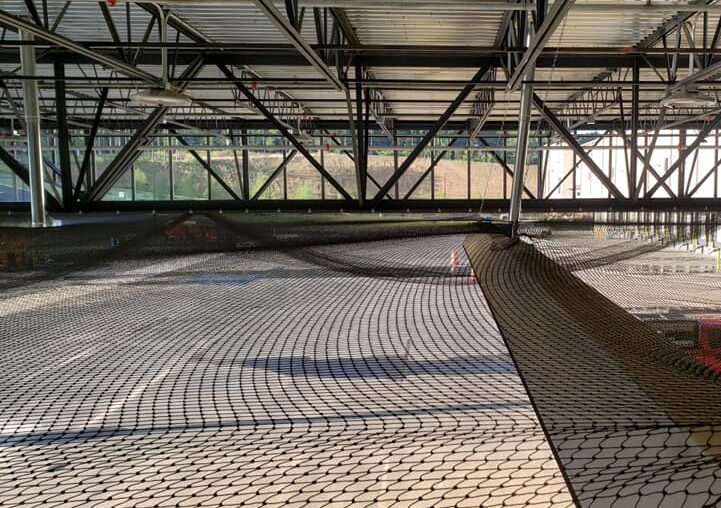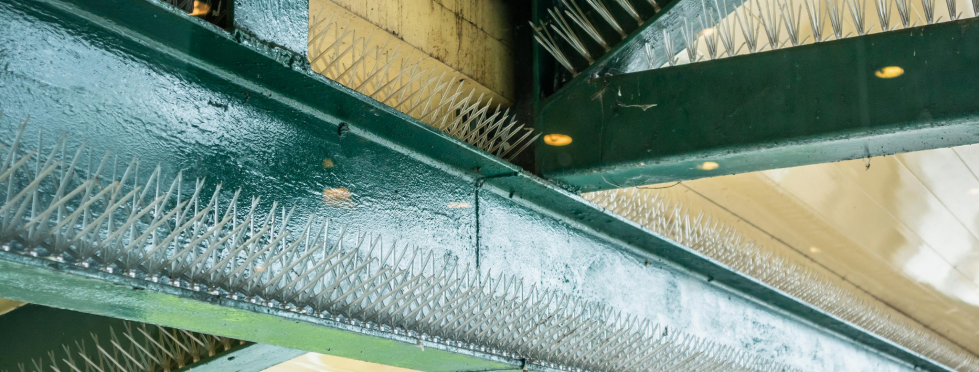Most bird species are welcome in urban areas and do not pose an immediate threat. However, a few species can flourish on food made available by human activities and become a pest if their numbers grow too large. Attracted by food and a secure haven, birds roost and nest in great numbers on buildings, causing damage and polluting the structure and its surroundings. Looking to Get Rid of Pest Birds in a Commercial Building?
Wildlife laws must be taken into account when it comes to regulating birds. In most countries, wildlife regulations protect certain bird species, which can only be disturbed or killed under certain conditions or during certain seasons.

Which birds are considered pests?
The following are the most common bird species that cause problems on commercial business properties:
Pigeons
Pigeons can congregate in large numbers on building ledges and roofs. This is a trait inherited from its wild ancestor, the cliff-dwelling rock dove. Their droppings, notably limestone and calciferous sandstone, can accumulate and damage building materials. The stone is corroded by a fungus that grows in the excrement, making the surface permeable to water, which subsequently breaks the stone when it freezes. Many historic buildings in cities like New York, Washington DC and Philadelphia are made of such susceptible stone.
Starlings
At night, vast flocks of starlings roost atop buildings, polluting the structures and nearby areas with their droppings. They will make their nests in cavity-like areas such as drainpipes, gaps in walls, and ceilings inside and around structures. They eat grains, waste food, insects, seeds, and berries as well as grains and waste food.
House Sparrows
House sparrows frequently build their nests in huge facilities that store or process food, such as factories and warehouses. They make big, filthy nests out of grass and leaves, and their droppings and nesting material contaminate surfaces and items. Pecking to get to the contents of packed goods can also cause damage.
Gulls
Several gull species are pests in coastal areas all over the world. They eventually realized that rooftops provided safe predator-free nesting locations and that metropolitan environments offered a variety of food supplies.
Herring gulls usually build their nests on the rooftops of houses, where their continual calling is a nuisance. The lesser black-backed gull, for example, prefers industrial structures with flat roofs. Gulls produce less fouling than pigeons, but their droppings can deteriorate roofing materials and accumulate up on rooftops, clogging drains.
Gulls are frequent at landfill sites in the United States, and they have been spreading further inland in recent years. They may be protected by wildlife law — in the United States, all species are protected, and destroying nests or birds requires permission.
Have a bird problem? Give us a call now! We service many areas and major cities in the USA
What Signs Indicate a Bird Infestation?
It is highly recommended that the confirmation of a bird infestation be facilitated before putting time and money into bird control on a commercial property. Correctly recognizing which pests are infesting a commercial property ensures that the right treatments are used to effectively control the pests that are hurting your company.
The following are some of the most common signs of a bird infestation:
- Birds building nests on rooftops, ledges, cables, and wires
- Debris: on rooftops, ledges, paved surfaces, automobiles, and merchandise
- Bird noises: a constant stream of bird sounds, particularly from young chicks. Bird nests can be found on rooftops, ledges, gutters, roof gaps, and beams.
- Debris from nests and feathers: debris strewn about your property, clogged gutters and drainage systems, water-damaged walls and ceilings
- Stock damage due to bird droppings and pecking
Get Rid of Pest Birds in Commercial Buildings
Birds, nests, and eggs are all protected under wildlife legislation. These restrictions apply not only to the nuisance bird you’re trying to eradicate but also to other bird species that may be harmed as a result of your efforts. To deploy controls in most nations, you’ll need a license and a skilled operator.
Contracting a wildlife removal company or a bird control specialist is key in protecting your commercial building and providing humane treatment of birds. A professional bird control company will be able to assess the needs of your building structure and business to install the best solutions and create a plan that works best for your environment to achieve optimal results. In many cases, the team will install protective bird barriers and perform preventative maintenance.
Bird Management of the Environment
The presence of food attracts birds to a location. Because of the numerous sources of food offered by food businesses, the public wasting food in open places, and people personally feeding birds, this is difficult to control in urban settings.
Food accumulation can be avoided by:
• Having trash cans in public places
• Prohibition of bird feeding
• Cleaning places prone to food debris or spills on a regular basis
• Keeping garbage cans closed and the area around them clean
• Businesses that practice general food hygiene, including waste management to prevent waste food and spills
Bird Exclusion
A variety of physical methods can be used to keep birds from roosting on or entering buildings. Nets, spikes, wires, and normal structure upkeep are examples of entry point exclusion. Birds usually get access to buildings through damaged roofs or loading bay areas, which can be covered by a variety of bird control methods and products. Hawking can also be used to frighten away bird pests by utilizing birds as prey.
Controlling the Bird Population
Adults cannot raise young on the location if eggs and nests are removed, hence the flock size is kept low. This necessitates several trips to the nesting spot, as well as the initial usage of fake eggs to prevent additional laying.
In some cases, birds can also be caught using baited cages or mist netting. Cages must be serviced on a regular basis to ensure that the birds are not left without food or water. The captured birds must next be treated with care and compassion. If you’re looking to Get Rid of Pest Birds in Commercial Buildings give us a call or contact us today for a consultation.
Contact an expert commercial bird net installer today at New Phone.

